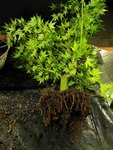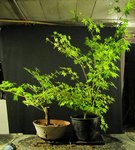I couldn't find back the thread in which there's a video of (Peter?) Chan explaining his technique of air-layering with sphagum moss.
I tried it, with some apprehension : chemical hormones are now banned here.
I had this air-layer taken years ago that I planted in my garden, but I didn't really pay attention to it, and a big root developped on one side. I uprooted it and put it in a plastic pot in 2018 I think.

20th June, a bit late, but I've had success with air-layers started in mid-July, so I thought "Why not?":

A sharp knife, some sphagnum moss soaked with "natural hormones", alcohol to disinfect the knife and the trunk :

I used the plastic bubble sheet that was at hand (a bit too thick) and filled the bottom with sphagnum moss and a little sand - I had some very good success previously using a medium with almost 90% aquarium sand, so for a first try, I thought I would stay on the safe side :

I then completed with 100% sphagnum moss :

Today, 4 weeks later, I carefully removed some of the sphagnum and I could see new roots :

I'll be away for a few days next week, I hope that the people who are supposed to come and water my tree won't forget : no rain in the past 3 weeks, 30° today, between 28 and 32 (82.4/89.6) next week, and when they say 32 it's usually 34-35 here (93.2/95). And no rain for the next two weeks...






















